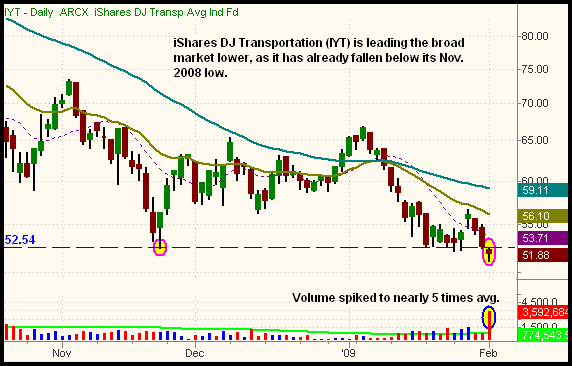|
The Wagner Daily ETF Report For February 3
Stocks got off to a negative start yesterday morning, chopped around in a sloppy, sideways range throughout the day, then finished with mixed results. Strength in the technology and biotech sectors enabled the Nasdaq Composite to log a 1.2% gain, but the blue-chip Dow Jones Industrial Average lost 0.8%. Splitting it down the middle was the broad-based S&P 500, which dipped less than 0.1%. The small-cap Russell 2000 advanced 1.4%, as the S&P Midcap 400 Index closed 0.3% higher. The S&P and Nasdaq closed in the upper third of their intraday ranges, but the laggard Dow settled near the middle of its range.
Total volume in the NYSE receded 10%, while turnover in the Nasdaq declined 5% below the previous day's level. The lighter volume was not surprising, as it was a rather dull, directionless day. Still, volume in both exchanges remained marginally above 50-day average levels. Like the closing prices, market internals were mixed. In the NYSE, declining volume exceeded advancing volume by a margin of approximately 3 to 2. The Nasdaq adv/dec volume ratio was positive by just under 2 to 1.
In yesterday's Wagner Daily, we illustrated the relative weakness the Dow Jones Industrial Average has been showing. In the afternoon, the Dow dipped below key support of its January intraday low of 7,909, but recovered to close above that important level. Still, on a closing basis, the Dow finished at its lowest level since November 20, 2008.
Falling to a fresh, multi-year low ahead of the Dow, and certainly putting pressure on the Dow Industrials, was the Dow Jones Transportation Average ($DJT). To illustrate this, take a look at the daily chart of the iShares DJ Transportation Index Fund (IYT), a popular ETF proxy for the $DJT:

As annotated by the dashed horizontal line on the chart above, notice how IYT has already fallen below its prior 52-week low from last November. Yesterday's volume in IYT also surged to nearly five times average, pointing to massive institutional activity. Interestingly, the price of crude oil is also in danger of dropping to a new multi-year low. In past years, there had been a loose correlation between the price of crude oil and the transportation stocks, but that is no longer the case. This is one example of how a seriously faltering economy can easily change technical market trends and correlations that were effective in the past. With the new low in Transports, those aware of "Dow Theory," which is based on the correlation between the Industrial and Transportation Averages, may want to have a look at this article.
In yesterday's commentary, we said, "On the plus side, the S&P and Nasdaq are still several percent above support of their January lows, which could help prop up the Dow." With the S&P 500 basically unchanged, and the Nasdaq rallying 1.2% yesterday, this is even more the situation. Despite the bearish patterns of the Dow Jones Transportation and Industrial Averages, the relative strength of the Nasdaq could make it tricky to enter the short side of the market near current levels.
If the Nasdaq wins the tug-of-war taking place in the broad market, iShares Nasdaq Biotech (IBB) is one ETF that could show leadership. Unlike most industry sector ETFs, IBB has been consolidating above its 50-day moving average for more than a month. Over the past few days, its range has tightened even more, as the 20-day exponential moving average now provides support as well. Any further strength in the Nasdaq should cause IBB to breakout, so we're monitoring IBB for potential buy entry above its four-day high. The daily chart of IBB is shown below:

As the charts above help to illustrate, the overall stock market is showing quite a few mixed signals right now. Though we don't know how long this uncertainty will continue, one thing is indeed certain -- caution is required in order to protect against overtrading. Choppy, range-bound markets are notorious for churning traders' accounts, so don't let this happen to you. At the least, you may want to avoid broad-based ETFs such as SPY, DIA, or QQQQ. On the long side, we still like gold/silver ETFs, and are monitoring biotech. On the short side, we're still in the UltraShort Real Estate ProShares (SRS), which we pointed out in yesterday's newsletter. Having a portfolio positioned on both sides of the market, with ETFs of a low correlation to overall market direction, is a good way to decrease your risk, while still allowing for substantial profits.
Open ETF positions:
Long - DGP, GDX, UGA, SRS
Short - (none, but SRS is a bearish position)
Deron Wagner is the Founder and Head Trader of both Morpheus Capital LP, a U.S. hedge fund, and Morpheus Trading Group, a trader education firm launched in 2001 that provides daily technical analysis of the leading ETFs and stocks. For a free trial to the full version of The Wagner Daily or to learn about Wagner's other services, visit MorpheusTrading.com or send an e-mail to deron@morpheustrading.com.
|